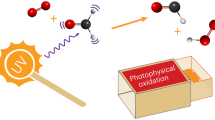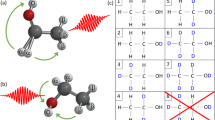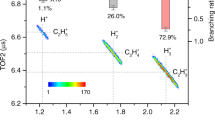Abstract
IT has been realized for some time that hydrogen atoms produced by photolysis of the hydrogen halides or of certain other hydrides possess kinetic energy in excess of that corresponding to thermal equilibrium1–5. This arises because the energy of the quantum absorbed is larger than the minimum required to disrupt the molecule into stationary atoms. For example, the dissociation energy of HI is 296 kJ moles−1 (ref. 6) and its first absorption maximum occurs at 220 nm7, corresponding to an energy of 539 kJ moles−1. As a result of conservation of momentum, most of the excess energy appears as translational energy of the hydrogen atom. Such hydrogen atoms are often described as “hot” and their energy is manifested in enhanced reactivity. Their reactions with HI1–3, H2S4, halogens1–4, D2 and several deuterated hydrocarbons (or the corresponding reactions of D or T with H2 or hydrocarbons)8–13 have been demonstrated, and in some cases the variation of reaction probability with wavelength of photolysis has been measured10–12.
This is a preview of subscription content, access via your institution
Access options
Subscribe to this journal
Receive 51 print issues and online access
$199.00 per year
only $3.90 per issue
Buy this article
- Purchase on Springer Link
- Instant access to full article PDF
Prices may be subject to local taxes which are calculated during checkout
Similar content being viewed by others
References
Ogg, R. A., and Williams, jun., R. R., J. Chem. Phys., 13, 586 (1945).
Williams, jun., R. R., and Ogg, R. A., J. Chem. Phys., 15, 691 (1947).
Schwarz, H. A., Williams, jun., R. R., and Hamill, W. H., J. Amer. Chem. Soc., 74, 6007 (1952).
Darwent, B. de B., Wadlinger, R. L., and Allard, M. J., J. Phys. Chem., 71, 2346 (1967).
Gann, R. G., and Dubrin, J., J. Chem. Phys., 47, 1867 (1967).
Wagman, D. D., Evans, W. H., Halow, I., Parker, V. B., Bailey, S. M., and Schumm, R. H., NBS Tech. Note 270–1, US Department of Commerce, Washington, 1965. All thermochemical data used are from this source.
Goodeve, C. F., and Taylor, A. W. C., Proc. Roy. Soc., A, 154, 181 (1936).
Carter, R. J., Hamill, W. H., and Williams, jun., R. R., J. Amer. Chem. Soc., 77, 6457 (1955).
Martin, R. M., and Willard, J. E., J. Chem. Phys., 40, 3007 (1964).
Kuppermann, A., and White, J. M., J. Chem. Phys., 44, 4352 (1966).
Kuppermann, A., Nobel Symp. 5 (Intersciences, New York, 1967).
Gann, R. G., and Dubrin, J., J. Chem. Phys., 50, 535 (1969).
Chou, C. C., and Rowland, F. S., J. Amer. Chem. Soc., 88, 2612 (1966).
Penzhorn, R. D., and Darwent, B. de B., J. Phys. Chem., 72, 1639 (1968).
Martin, R. M., and Willard, J. E., J. Chem. Phys., 40, 2999 (1964).
Fenimore, C. P., and Jones, G. W., J. Phys. Chem., 62, 1578 (1958).
Dixon-Lewis, G., Sutton, M. M., and Williams, A., Trans. Faraday Soc., 61, 255 (1965); Tenth Combustion Symp., 495 (1965).
Baulch, D. L., Drysdale, D. D., and Lloyd, A. C., High Temperature Reaction Rate Data 1, University of Leeds (1968).
Dixon-Lewis, G., Sutton, M. M., and Williams, A., J. Chem. Soc., 5724 (1965).
Wolfgang, R., Progress in Reaction Kinetics, 3 (Pergamon, London, 1965).
Author information
Authors and Affiliations
Rights and permissions
About this article
Cite this article
OLDERSHAW, G., PORTER, D. Direct Determination of Threshold Energies for the Reactions of Hydrogen Atoms with N2O and with CO2. Nature 223, 490–491 (1969). https://doi.org/10.1038/223490a0
Received:
Revised:
Issue Date:
DOI: https://doi.org/10.1038/223490a0
Comments
By submitting a comment you agree to abide by our Terms and Community Guidelines. If you find something abusive or that does not comply with our terms or guidelines please flag it as inappropriate.



